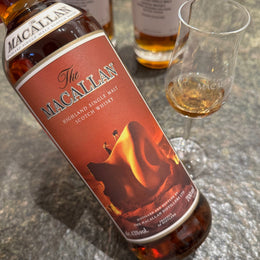
In 1892, Scottish businessman William Grant – already famed for founding Glenfiddich Distillery – began the process of clearing the overgrown vines off a 18th-century estate. Salvaging second-hand copper stills from Lagavulin and Glen Albyn, Grant’s new distillery fired up its stills for the first time in May 1893. And as it was nestled by the medieval ruins of the 13th century Balvenie Castle, the estate and ultimately the distillery that it became, took the auspicious name “Balvenie”, meaning “village of luck”. The Balvenie remains under the ownership of the same Grant family to this day.
In its early years, The Balvenie’s malt whisky was just a hidden gem in William Grant & Sons’ stable. In the mid-20th century, if you enjoyed a bottle of Grant’s blended whisky, chances are there was a measure of Balvenie malt in the mix. It was mainly used as a component of the Grant family’s blended whiskies. This began to change after the company saw Glenfiddich (Balvenie’s older “sibling” next door) successfully sparking the single malt revolution in the 1960s by marketing itself as a stand-alone “single malt whisky”.


Seeing Glenfiddich’s success, around the mid 1960s, the Grant family decided to give Balvenie its own moment in the spotlight. 8 years later in 1973, Balvenie was finally bottled as a single malt for the first time – an 8-year-old expression that turned out to be a serendipitous hit with its signature mellow, honeyed character. Packaged in a distinctive triangular bottle (matching Glenfiddich’s iconic green triangular bottle), the original Balvenie 8 proved that the distillery’s spirit could stand proudly on its own.

(Source: ScotchWhisky.com)
Then came the 1980s which was a tumultuous time for Scotch whisky. After the boom of the 1960s, the industry hit a wall of declining demand in the late 1970s, resulting in a huge oversupply of maturing whisky that far outstripped consumption – known as the Whisky Loch crisis. Yet, within Balvenie Distillery in 1982, Malt Master David Charles Stewart – responsible for selecting casks and creating the house style – saw an opportunity amid the surplus.
David wondered: what would happen if you took mature Balvenie whisky out of its barrel and put it into a different kind of cask for a short time?

The Balvenie's legendary former Malt Master David Stewart MBE and his apprentice, now Malt Master, Kelsey McKechnie.
In other words, could you “finish” the aging process in a second cask to add new flavours? Today the idea of “cask finishing” sounds obvious, but in the early 1980s it was unthinkable. Back then, single malts were typically fully aged in one type of cask: usually ex-bourbon barrels (yielding a golden whisky with vanilla sweetness) or ex-sherry butts (giving a darker, nutty, fruity character). Tradition held that you filled a cask and left the whisky there until it was bottled, period. But David thought differently. He knew that good sherry casks were getting scarce and expensive in the 1980s (fewer Spanish sherry were being made and exported, so the once-plentiful sherry butts were no longer easy to obtain). At the same time, Balvenie’s warehouses held lots of excellent whisky aging in American oak ex-bourbon barrels.
David suspected that a secondary finishing period could combine the best of both worlds: the smooth honeyed base from American oak with an extra overlay of dried fruit, spice, and depth from a spell in oloroso sherry wood.
So in 1982, David conducted a quiet experiment – finishing an ex-bourbon matured whisky in European oak Oloroso sherry butts for a number of additional months. The resulting whisky, bottled the following year in 1983, was called The Balvenie Classic – essentially the early form of The Balvenie DoubleWood whisky which was created in an era when single cask type maturation was the norm. The innovation paid off splendidly. The sherry-“finished” Balvenie Classic wowed those who tried it, exhibiting greater depth of flavour than a bourbon-cask whisky alone could.

For his contributions, David Stewart has been richly honoured. The Crown awarded him an MBE (Member of the Order of the British Empire) in 2016 for services to the Scotch whisky industry. The Scotch industry had began adopting David’s cask finishing process widely from the 1990s onwards
Yet, if cask “finishing” was the buzzword of the 1990s in Scotch, “marrying” might be the key term for Balvenie’s approach to extremely well-aged whisky in the 2020s.
In 2021, The Balvenie introduced a new range of ultra-premium single malts called the Rare Marriages series. This collection – consisting of The Balvenie 25, 30, and 40-year-old expressions – goes in the opposite direction from cask finishing.

Once David and his apprentice malt master have combined the chosen casks, the marriage isn’t bottled right away. The vatted whisky is poured into Balvenie’s traditional oak marrying tun, a large oak vessel, where it is allowed to rest and integrate for a certain period (typically a few months) before bottling.
While underappreciated by many producers in a hurry, this step is critical. In blending parlance, marrying is like a “whisky honeymoon” – the newly mingled spirits spend time getting to know each other, rounding off any sharp edges and forming a unified profile
Rather than emphasising an extra cask at the end of maturation, these whiskies are enhanced by blending and marrying multiple well-aged casks to create a balanced masterpiece.

Former Malt Master David Stewart MBE beside one of these marrying tuns.
Now we recently had the opportunity to have a taste of The Balvenie 25 Years Old. This expression is made from a small number of casks that David hand-selected and blended, predominantly matured in American oak ex-bourbon refill barrels, with a smaller portion of whisky matured in European oak Oloroso sherry casks – poured into The Balvenie’s traditional oak marrying tun where it is allowed to rest and integrate for several months before bottling.
Let’s give this a taste!
Whisky Review: The Balvenie 25 Years Old, Rare Marriage, 48 % ABV

Nose: Opens with the unmistakable signature The Balvenie warm, honeyed roundness, but here it’s dialled up into something far more layered and defined. The malt character is front-and-center with biscuits, brown sugar and caramel edges that reads almost like the crust of a brûlée. Behind that, I catch a gentle mineral thread of light slate. Then come the fruits – soft, stewed apples, like the filling of an apple pie just pulled from the oven, followed by a brighter lift of caramelised pineapple and ripe nectarine. There’s a sweet citrus touch too, more like orange peel than juice that is fragrant, slightly bitter, and candied.
Palate: Lands on the palate with a thick, rounded texture, a richness that’s indulgent but not overwhelming. Golden syrup and honey saturate the front palate, with a firm malty backbone keeping it grounded. The fruit expands slowly and generously, like a warm fruit compote. Again, the pineapple returns, now deeper and caramelised, alongside stewed stone fruits. Floral accents emerge partway through with soft orange blossoms. Toward the back, there’s toasted coconut, vanilla and a spread of baking spices. A nutty note lingers with toasted almonds and a faint trace of macadamia.
Finish: Long , persistent and composed. The honey persists through to the end, joined by orange segments soaked in syrup. It never becomes cloying– there’s always a lift from the citrus and a gently warming presence from the spice.

My Thoughts
This is immediately recognisable as The Balvenie with those signature honeyed sweetness being right there from the start, with a remarkable layering of tropical fruit depth, a malty density, floral lift, and just enough nutty warmth and spice.
The tropical depth was unexpected, and its integration with the classic profile really makes it feel like The Balvenie turned up to 11, but without ever tipping over into excess, always staying incredibly vibrant.

@CharsiuCharlie






